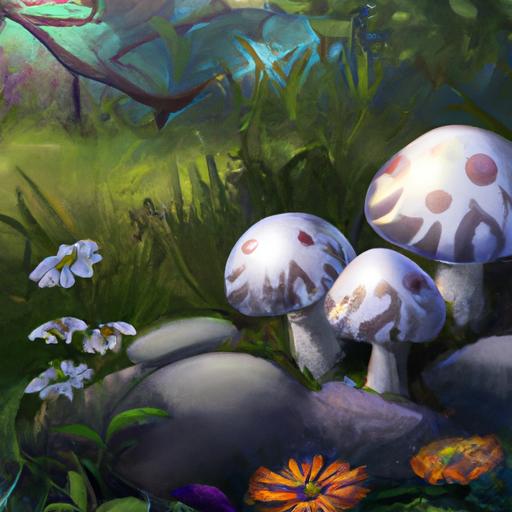Mushrooms are a popular and versatile ingredient in many dishes, but when you find brown spots on them, it can be hard to know if you should still eat them.
If youve ever wondered if button mushrooms with brown spots are still safe to eat, then youre in the right place! In this article, well explore the causes behind mushrooms developing brown spots, the signs that indicate if a mushroom with brown spots is safe to eat, the nutritional benefits of eating them, and the best ways to prepare them.
So grab your apron and get ready to learn all about brown spotted mushrooms the answer may surprise you!
Table of Contents
Short Answer
Yes, you can eat button mushrooms with brown spots.
They are usually just signs of the mushroom aging and are still safe to eat.
However, if the brown spots have become slimy or the mushroom has started to decay then it is best to discard it.
Additionally, if the brown spots look like mold then it is best to not eat the mushroom as it can cause foodborne illness.
What Causes Mushrooms to Develop Brown Spots?
The brown spots that can be found on mushrooms are caused by a natural process known as oxidation, or the exposure of the mushroom to oxygen.
This can happen when mushrooms are left out of the refrigerator for too long or when they are stored improperly.
Oxidation can also occur when mushrooms are cut or bruised, as the oxygen can reach the inside of the mushroom.
The brown spots that appear are simply a sign of the mushrooms age and are not an indication that the mushroom has gone bad.
In fact, the mushrooms are still safe to eat and can be cooked in the same way as regular white button mushrooms.
It is important to note, however, that the mushrooms should not have an off smell.
If they do, they should be discarded immediately as they may have gone bad.
Additionally, you should make sure to check the mushrooms for any signs of mold before eating them.
Mold can also indicate that the mushrooms have gone bad and should not be consumed.
The brown spots on mushrooms can be scraped off, but this is not necessary as they will cook away with the heat.
So, if you have mushrooms with brown spots, you can still go ahead and cook them just like you would any other mushroom.
How to Identify If Mushrooms with Brown Spots Are Safe to Eat

When it comes to mushrooms with brown spots, it can be tricky to tell if they are safe to eat.
Fortunately, there are some helpful tips you can use to determine if your mushrooms are still safe to consume.
First, inspect the mushrooms carefully for any signs of mold, discoloration, or soft spots.
If any of these are present, the mushrooms should not be consumed.
Additionally, make sure to check for any off smells.
If the mushrooms smell unusual, this is a sign that they have gone bad and should not be eaten.
Next, take a closer look at the brown spots.
If they appear to be raised, this is a sign that the mushrooms may have gone bad and should be discarded.
On the other hand, if the spots are flat and discolored, this is a sign that the mushrooms are simply older and still safe to eat.
Finally, you can also test the mushrooms by cooking them.
If they are still safe to eat, they will cook up as normal.
If they are bad, the mushrooms will have an off smell and taste.
If this is the case, it is best to discard them.
In conclusion, it is possible to eat mushrooms with brown spots.
However, it is important to inspect them carefully and discard any that have signs of mold, soft spots, or an off smell.
Additionally, cooking the mushrooms can help you determine if they are safe to eat.
Are All Brown Spotted Mushrooms Safe to Eat?
The answer to this question is yes, all brown spotted mushrooms are safe to eat.
While the brown spots may look unappealing, they are usually caused by a natural process and do not indicate that the mushrooms have gone bad.
In fact, the spots are simply a sign of age and can be scraped off or cooked away.
However, it is important to note that if the mushrooms have an off smell, they should be discarded as they may have gone bad.
This is because mushrooms can become contaminated with foodborne bacteria if they are not stored properly or have been exposed to moisture or heat.
Therefore, it is best to use your senses when checking mushrooms for freshness.
If they smell off or look slimy or discolored, it is best to throw them out.
The same rules apply for button mushrooms with brown spots.
Even though they may be safe to eat, it is best to discard them if they have an off smell or look discolored.
If they are fresh, however, they can be cooked and enjoyed just like regular white button mushrooms.
In conclusion, it is safe to eat mushrooms with brown spots.
However, it is important to use your senses when checking for freshness and to discard mushrooms if they have an off smell or look discolored.
With proper handling and storage, you can enjoy these mushrooms in your favorite recipes.
Nutritional Benefits of Eating Brown Spotted Mushrooms

Mushrooms are a great source of nutrition, and brown spotted mushrooms are no exception.
These mushrooms contain a variety of vitamins and minerals, including vitamin D, iron, magnesium, potassium, and zinc.
They are also a good source of fiber, protein, and antioxidants, which can help support a healthy immune system.
Additionally, they are low in calories and fat, making them a great addition to any diet.
Button mushrooms with brown spots also contain a unique type of fiber called chitin, which has been shown to have anti-inflammatory properties.
In addition, the antioxidants found in these mushrooms can help fight off free radicals, which can lead to cell damage and premature aging.
The nutritional benefits of these mushrooms make them a great addition to any meal.
They can be eaten raw, cooked, or added to a variety of dishes.
They are especially delicious when sauted with garlic and butter, or added to soups, pasta dishes, and stir fries.
Adding them to your meals can help boost your intake of essential vitamins and minerals, as well as provide a delicious and healthy addition to your plate.
Tips for Preparing Brown Spotted Mushrooms
When preparing mushrooms with brown spots, the first step you should take is to give them a good cleaning.
Brown spotted mushrooms can be washed in a colander under running water or wiped down with a damp paper towel.
If there are any tough spots, you can use a vegetable brush to scrub them away.
When cooking brown spotted mushrooms, it is important to remember that they can be cooked the same way as regular white button mushrooms.
They can be cooked in a skillet, stir-fried, grilled, roasted, or added to soups or stews.
If you want to remove the brown spots, you can scrape them off with a knife before cooking.
When storing your mushrooms, it is best to keep them in a paper bag in the refrigerator.
Brown spotted mushrooms can last for up to a week in the refrigerator before they start to spoil.
If the mushrooms have an off smell or feel slimy, then it is best to discard them.
Finally, it is important to remember that mushrooms are a great source of vitamins and minerals.
They are high in Vitamin D, Vitamin B, selenium, potassium, and more.
So, if you are looking for a healthy and delicious snack, brown spotted mushrooms are a great option.
Recipes Utilizing Brown Spotted Mushrooms

Cooking with brown spotted mushrooms can actually be an exciting and delicious way to add flavor and texture to many dishes.
From soups to stir-fries, mushrooms can be used to add texture and complexity to a variety of recipes.
Here are some simple and flavorful recipes that can be easily created using mushrooms with brown spots.
For a unique and flavorful appetizer, try sauted mushrooms.
Start by cleaning the mushrooms with a damp cloth and scraping away any brown spots.
Heat a tablespoon of olive oil in a frying pan over medium heat and add the mushrooms.
Cook for 3-4 minutes, stirring occasionally, until the mushrooms are golden brown.
Add a pinch of salt and pepper to taste and serve hot with your favorite dipping sauce.
Mushrooms can also be added to salads for a unique and flavorful twist.
Start by washing and slicing the mushrooms.
Heat a tablespoon of olive oil in a frying pan over medium heat and add the mushrooms.
Cook for 3-4 minutes, stirring occasionally, until the mushrooms are golden brown.
Remove from heat and let cool.
Add the mushrooms to a bed of greens, along with your favorite vegetables for a delicious and healthy salad.
Mushrooms also make a great addition to soups and stews.
Start by cleaning the mushrooms with a damp cloth and scraping away any brown spots.
Heat a tablespoon of olive oil in a large pot over medium heat and add the mushrooms.
Cook for 3-4 minutes, stirring occasionally, until the mushrooms are golden brown.
Add the mushrooms to your favorite soup or stew recipe and let simmer.
The mushrooms will add a unique and flavorful twist to the dish.
These are just a few recipes that can be created using mushrooms with brown spots.
These mushrooms are perfectly safe to eat and can add a unique and flavorful twist to many dishes.
So next time you find mushrooms with brown spots, dont throw them away! Give these recipes a try and enjoy the deliciousness that these mushrooms have to offer.
Alternatives to Eating Brown Spotted Mushrooms
If you’re not a fan of mushrooms with brown spots, there are other options to enjoy the wonderful flavor of button mushrooms.
For starters, you can look for white mushrooms without any spots, which are typically younger and less aged.
Additionally, you can also look for mushrooms that are labeled “pre-sliced” or “pre-cleaned” to ensure they are free of any unsightly spots.
In addition to white button mushrooms, there are several other varieties available that don’t have brown spots.
These include shiitake, oyster, portobello, and cremini mushrooms.
These varieties are especially good for grilling or roasting, as they are larger than button mushrooms and can hold up to higher temperatures.
If you’re in the mood for something a bit more flavorful, you can also try specialty mushrooms such as chanterelles, porcinis, or morels.
These mushrooms are often more expensive than white button mushrooms, but their unique flavors and textures can make them a great addition to any dish.
Finally, for a truly unique flavor, you can also try dried mushrooms.
Dried mushrooms are reconstituted in water before being added to dishes, and they can add a rich and earthy flavor that is sure to make your dish stand out.
No matter which variety you choose, the important thing to remember is that you can still enjoy the wonderful taste of mushrooms without the brown spots.
Final Thoughts
If you are wondering if you can eat mushrooms with brown spots, the answer is yes! Brown spots are a natural process and the mushrooms are safe to eat.
To ensure that the mushrooms have not gone bad, make sure to check for any off smells.
Brown spotted mushrooms are a great way to add extra nutrition to your meals and can be cooked in a variety of ways.
Try out some of our delicious recipes featuring brown spotted mushrooms, or use them as a healthy alternative to other ingredients.
Now that you know the truth about brown spotted mushrooms, don’t be afraid to give them a try!

